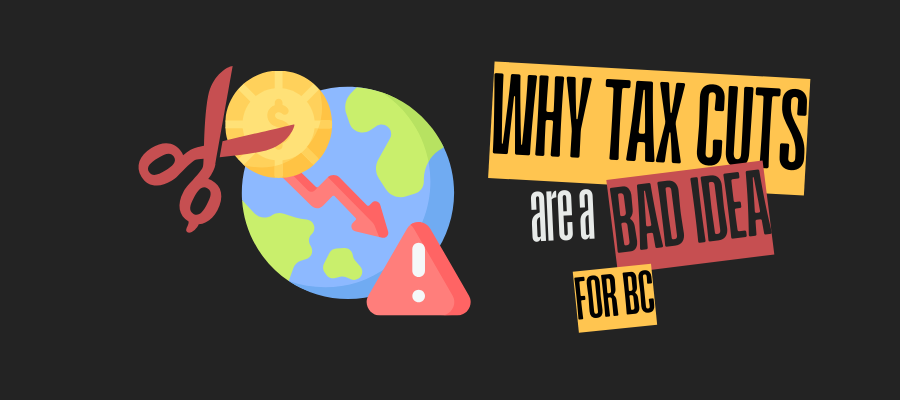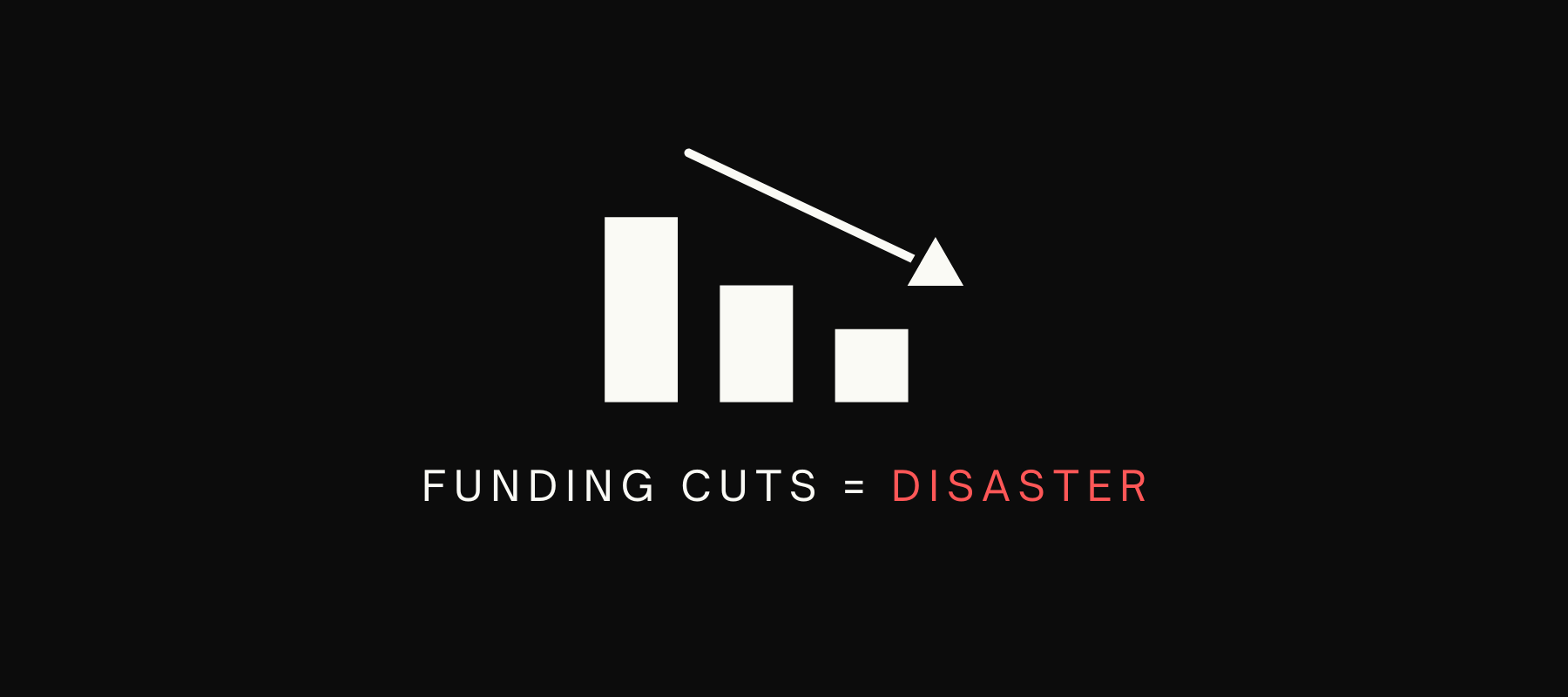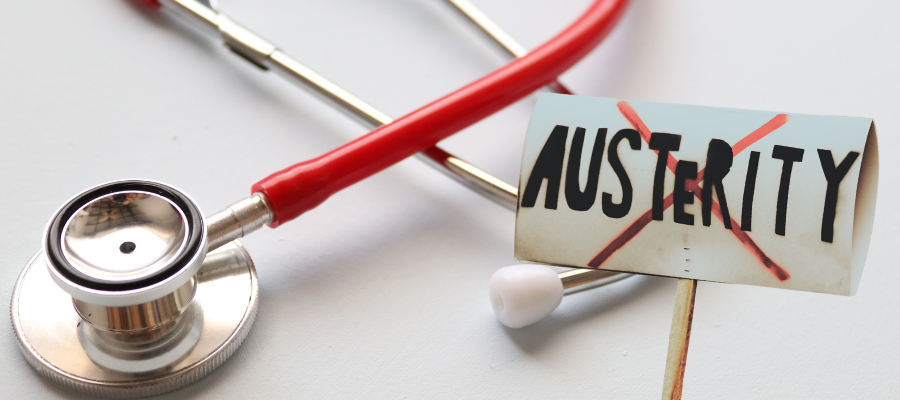Tax cuts would come back to bite BC

In the BC election, significant tax cuts were put on the table by both the BC Conservatives and BC NDP in their policy platforms. While they were framed as a way of easing pressures on the cost of living, tax cuts would do little to address the structural problems underlying those cost pressures.
Now that the provincial election has been decided and the BC NDP will return to government, we can take a closer look at the impacts of the tax cuts they proposed during the campaign.
More tax cuts in BC would erode the province’s capacity for public investments to tackle some of the big challenges we face: housing, health care, child care, poverty, toxic drugs and the climate crisis, among others. Tax cuts would ultimately deepen the affordability challenges they purport to help.
The legacy of neoliberal tax and spending cuts in BC
Tax and spending cuts of the neoliberal era are among the key causes of the significant social challenges we face today. In the early 2000s, the BC Liberal government made cuts to public services paired with large across-the-board personal and corporate tax cuts that disproportionately benefited the rich.
The harms of cuts to public services were widespread. In the K-12 education system, schools closed by the dozens and class sizes grew. Thousands of health care support workers saw their jobs privatized, leading to large wage cuts and degraded working conditions and quality of service. The government of the day largely got out of the business of building affordable housing, helping to set the stage for the housing shortage today. The BC Liberals also failed to invest adequately in affordable child care and underinvested in infrastructure, even selling off public lands needed for schools and hospitals.
Following these tax and spending cuts, the role of public spending in BC’s economy was seriously diminished. As a share of GDP, provincial government operating spending dropped sharply in the early 2000s and still remains lower today than it was 25 years ago. This is despite some important reinvestments in social programs since the BC NDP formed government in 2017.

By the 2023/24 fiscal year, provincial operating spending stood at 20.7% of GDP, down from 21.5% in 1999/00. This belies corporate and right-wing claims that BC is engaging in “reckless” spending. Core provincial government staffing levels per capita also remain substantially lower than they were a quarter century ago, falling from 1.06 full-time equivalent (FTE) staff per 100 British Columbians in 1999/00 to 0.83 FTE in 2023/24 (up from a low of 0.71 FTE per 100 residents in 2005/6).1
The revenue side of provincial finances tells a similar story. Provincial revenues as a share of GDP dropped sharply after the tax and spending cuts of the early 2000s, and they haven’t recovered since. Revenue stood at 19.4% of GDP in 2023/24, still down from 21.4% of GDP in 1999/00. This metric helps show that, as a society, British Columbia has the option to dedicate more of our total economic pie to solving difficult challenges through our shared institutions of government, if we choose to do so.

After the BC NDP took office in 2017, the government did shore up revenue by bringing in small tax increases on high incomes, corporations and the high end of the housing market. However, this was offset by a large tax cut in the form of eliminating unfair Medical Services Plan (MSP) premiums—a welcome change—with lost MSP revenue only partly replaced by a new Employer Health Tax (similar to that found in other large provinces). Taken together, these tax policy changes under the BC NDP were an important step forward for tax fairness, but they netted no structural increase to provincial revenues.
Another element of BC’s fiscal situation relates to provincial capital spending (distinct from operating spending) on infrastructure like schools, hospitals, roads and transit. Capital spending doesn’t affect the budget balance in the same way as operating spending. Borrowing is used to finance capital investment and is repaid gradually over the course of the life of an asset, with costs spread over many budget years.
Capital spending has increased substantially in recent years, reflecting the need to catch up on long-neglected infrastructure investment. Given the flurry of infrastructure promises on all sides in the provincial election, political parties now seem to agree on the importance of catching up on infrastructure investment (though not necessarily on the types and specific projects to be prioritized). Infrastructure investment is widely seen as a necessity and has clear long-term economic benefits. Failing to invest adequately in infrastructure now would only damage BC’s economy and revenues in the longer term.
BC has some fiscal room to maneuver—for the time being
If increased public investment is needed to meet the challenges BC faces, the question arises: can we afford it? The short answer is yes. But in the longer term that must include raising more revenue.
BC is running substantial operating deficits. In the election, the BC NDP and BC Conservatives both said they would continue running deficits in the years ahead while aiming to balance the budget over time.
Running deficits is reasonable in the coming years and is well-justified right now to help support demand in a weakening Canadian economy. BC has retained the best set of credit ratings of any province in Canada, despite projecting substantial deficits. BC also has among the lowest debt-to GDP-ratios of the provinces, leaving considerable room to maneuver particularly when borrowing to catch up on investment in infrastructure. Currently projected deficits may also be overstated as there are over $10 billion in contingency funds built into BC’s budget framework over the next three years.
Moreover, running fiscal deficits is far preferable to shortchanging public investment, which would only deepen social and environmental deficits and cost BC and its economy more in the long run.
Does this mean that BC should plan to run large deficits indefinitely? No.
Proposed tax cuts would be a step backwards
To sustain and increase important public investments in the years ahead, BC should increase provincial revenues as a share of GDP. The government certainly shouldn’t create long-term reductions in provincial revenues with tax cuts. Yet, that was put on the table in the recent election.
The BC NDP’s proposed “middle-class tax cut” would cost an estimated $1.3 billion on full implementation in 2026/27 (with that cost ongoing in subsequent years).2 This tax cut takes the form of a $10,000 increase to the basic personal amount exempted from provincial income tax, though it would be phased out for people with incomes above $125,000 a year (this is according to media reports; the policy details relating phase outs were not specified in the party election platform or news release).
More immediately, in the upcoming 2025/26 fiscal year, the BC NDP proposed an interim rebate that would cost an estimated $1.8 billion. The higher cost in the first year likely reflects that the interim rebate would flow to some lower income households that wouldn’t benefit from the eventual tax cut (because they don’t pay enough provincial income tax), though this isn’t spelled out in the platform. The revenue loss from the proposed BC NDP tax cut is offset marginally by an increase to the Speculation and Vacancy Tax that would add an estimated $60 million in revenue annually.
BC should increase provincial revenues as a share of GDP.
Notably, the $1.3 billion annual hit to provincial revenues from the BC NDP tax cut is much smaller than the income tax cut the BC Conservatives proposed (an estimated $3.5 billion cost for the “Rustad rebate” on full implementation)3, but the NDP cut is still significant on the scale of the $90 billion provincial budget.
Moreover, neither party’s proposed tax cuts are designed particularly fairly. First, those with lower incomes wouldn’t receive the full value of income tax cuts since they owe less provincial income tax to begin with. The Rustad rebate would have been even less fair since those with higher mortgage payments or rents (and likely higher incomes) would have received larger tax cuts under the policy.
Finally, one other consideration is that the BC NDP has proposed eliminating the consumer portion of the carbon tax, if the federal requirement is removed in the future. This remains a hypothetical and is unlikely to occur before the next federal election, so the issue isn’t likely to arise in BC’s next budget (but could come up at the time of the 2026 BC budget). This would erode provincial revenues further.
Raising revenue by taxing the rich
Instead of more tax cuts, BC should pursue policies to tax the rich and large corporations more robustly. Shoring up the tax base in this way would have the dual benefits of tackling inequality and helping fund key public investments that can meet the challenges facing British Columbians.
Income inequality in Canada recently hit a new record by one important measure (the largest recorded gap in disposable income between the top 40% and bottom 40%) and wealth inequality is at extreme levels including a huge gap between renter households and those who own real estate.
The idea of increasing provincial revenues is not pie in the sky. BC remains a low tax province. Even credit rating agencies like Moody’s have repeatedly noted that BC has “flexibility to raise taxes if necessary while still remaining competitive with other jurisdictions.”
Taking steps towards restoring provincial revenues to the share of GDP that BC had 25 years ago would greatly boost fiscal capacity. As discussed above, provincial government revenue stood at 19.4% of GDP last year (2023/24), down from 21.4% of GDP in 1999/00. If last year it had been at the earlier level of 21.4% of GDP that would have meant $8.2 billion in additional available revenue.
The idea of increasing provincial revenues is not pie in the sky.
There are numerous ways to restore provincial revenues as a share of GDP, including higher taxes on wealthy landowners, large corporations and those with the highest incomes. Moving in this direction would build on the modest but important steps already taken by the BC NDP government to improve tax fairness. The BC Green Party platform also notably called for inequality-reducing tax policies of this kind.
But the government’s planned provincial income tax cut (increasing the basic personal amount) would only deepen the revenue-raising challenge. If this policy does go ahead, it should phase out at a lower income level than $125,000 and be designed so that benefits will flow to those with low incomes who don’t pay provincial income taxes to begin with. Better yet would be to put the $1.3 billion cost of the planned tax cut towards programs that serve low- and middle-income people and towards increases in existing income-tested transfers like the climate action tax credit. If the tax cut does go ahead, it should be paired with raising new revenue from taxes on the rich and large corporations.
Increased economic growth can also contribute to raising provincial revenues (though it certainly can’t do the whole job). Policies to address the housing crisis, build out infrastructure and transportation networks and create a universal child care system can help increase economic growth and productivity.
BC is a wealthy, but highly unequal, province. Tax and spending cuts of the early 2000s deepened inequalities and eroded the government’s capacity to meet people’s needs and tackle big challenges. Rather than diminishing the capacity of our public sector with more tax cuts, BC should restore that capacity.
Notes
- These staffing figures are calculated from Table A9 in the Ministry of Finance’s First Quarterly Report, September 2024, and, for earlier years, Table A2.9 in the 2011 British Columbia Financial and Economic Review. The full-time equivalent (FTE) reporting does not include staffing in SUCH sectors: schools, universities, colleges and hospitals.
- The $1.3 billion figure for full implementation comes from the NDP’s platform document, and it also aligns with my effort to replicate the proposed tax cut using Statistics Canada’s SPSD/M database and model (with the caveat that not all policy design details of the tax were made clear in the platform document).
- Some guess work is required because the BC Conservative platform was costed only belatedly and incompletely. The widely cited price tag for the Rustad rebate of $3.5 billion originated with comments from party leader John Rustad. This is likely an overestimate because it appears to be based on the assumption that every household would receive the maximum rebate, which wouldn’t be the case. The party’s platform only provided the cost in the first year ($900 million) with a smaller rebate – not the cost once the full rebate was in place in 2029.
Topics: Economy, Election commentary, Provincial budget & finance, Taxes


